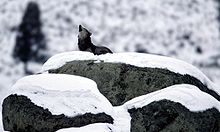Wikipedia:Featured picture candidates/Wolf howling on glacial erratic
Appearance


I uploaded this picture a few months ago when I was helping the Gray Wolf during a peer review/fac nomination. I was looking through the pictures I've uploaded today, and figured that this has potential to be an Featured Picture. So I decided to nominate it here for the approval of the voters. --ZeWrestler Talk 04:10, 25 December 2005 (UTC)
- Nominate and support. - ZeWrestler Talk 04:10, 25 December 2005 (UTC)
- Comment: Unfortunately, this photo is not very sharp. --Janke | Talk 09:08, 25 December 2005 (UTC)
- Comment Sorry, this has no chance at all, it's too blurred - Adrian Pingstone
- I did a touchup to the picture with photoshop, does that help at all? --ZeWrestler Talk 17:02, 25 December 2005 (UTC)
- Oppose Photo is unrecoverably blurry. Edit has noticeable artifacts. ~MDD4696 (talk • contribs) 17:08, 25 December 2005 (UTC)
 Oppose - This photo *could* actually be recovered fairly well in photoshop.. just very skillfully. Don't worry about the rock being sharp.. because when you apply the sharpen filter to the entire image, you're just causing unnecessary damage to the entire thing. Just do a pixel-select on the wolf, sharpen it, then edit the contrast/levels to make the photo a little brighter and more attractive.. if I had photoshop on this machine I'd do one for you but unfortunately I do not. Good luck. Might change vote if the final edit looks better.
Oppose - This photo *could* actually be recovered fairly well in photoshop.. just very skillfully. Don't worry about the rock being sharp.. because when you apply the sharpen filter to the entire image, you're just causing unnecessary damage to the entire thing. Just do a pixel-select on the wolf, sharpen it, then edit the contrast/levels to make the photo a little brighter and more attractive.. if I had photoshop on this machine I'd do one for you but unfortunately I do not. Good luck. Might change vote if the final edit looks better.
- Comment You are incorrect about being able to recover the image in Photoshop. Using a sharpening filter does not add detail to the image; it enhances the detail already there. It is a powerful program, but it's not magical enough to defeat the laws of mathematics. All image processing programs use the equivalent of a "high pass filter" in signal processing to sharpen images. That is, it actually removes "low frequency" (subtle gradient) image information so that "high frequency" (edge) information is more apparent. Anyways, in this particular case, sharpening any part of the image, even just the wolf, makes the JPEG artifacts in the sharpened areas significantly more noticeable. They're already there in the original, they're just very subtle. To remove those artifacts, even with a custom artifact removal filter, the image processing software must do some guesswork that results in some blurring... which defeats the purpose of editing the image in the first place! ~MDD4696 (talk • contribs) 01:29, 26 December 2005 (UTC)
- Comment Of course, you could edit it all by hand (with the paintbrush or something), but then it becomes more of a digital painting rather than a cleaned up photograph. ~MDD4696 (talk • contribs) 04:25, 26 December 2005 (UTC)
- Comment - I didn't say you could add detail, but it certainly could be adjusted to look a little better. Even if not a featured picture, the actual image deserves cleaning up for its use in the article. I'm sorry I used the word "recover," I do realize that implies retrieving data that no longer (/never did) exist. Some good folks at Stanford (I think) have though figured out a way to adjust the depth-of-field after the picture has been taken, though it requires a special camera. very interesting stuff. drumguy8800 - speak? 05:02, 26 December 2005 (UTC)
- Comment You are incorrect about being able to recover the image in Photoshop. Using a sharpening filter does not add detail to the image; it enhances the detail already there. It is a powerful program, but it's not magical enough to defeat the laws of mathematics. All image processing programs use the equivalent of a "high pass filter" in signal processing to sharpen images. That is, it actually removes "low frequency" (subtle gradient) image information so that "high frequency" (edge) information is more apparent. Anyways, in this particular case, sharpening any part of the image, even just the wolf, makes the JPEG artifacts in the sharpened areas significantly more noticeable. They're already there in the original, they're just very subtle. To remove those artifacts, even with a custom artifact removal filter, the image processing software must do some guesswork that results in some blurring... which defeats the purpose of editing the image in the first place! ~MDD4696 (talk • contribs) 01:29, 26 December 2005 (UTC)
- Oppose. Too grey, too boring, wolf is too small. Alr 22:26, 25 December 2005 (UTC)
- Oppose. Not bad, but not FP quality. I agree with the comments above about it being blurry; the edited version has simply enhanced the artifacts, especially near the wolf. Also, too much rock for my liking. enochlau (talk) 06:42, 26 December 2005 (UTC)
- ( − ) Oppose Agree with enochlau --Fir0002 00:16, 27 December 2005 (UTC)
- Oppose. Blurry background is distracting, and it bothers me that so much of the wolf is obscured by the rocks. Camerafiend 02:40, 27 December 2005 (UTC)
- Oppose The wolf is much too small. It can barely be seen because of the rocks. Cobra 09:11, 31 December 2005 (UTC)
- Oppose, at first I thought the snowy rocks were the purpose of the picture... Wolf should definitely be focused in on.--ʀ6ʍɑʏ89 17:06, 2 January 2006 (UTC)
Not promoted Raven4x4x 03:01, 8 January 2006 (UTC)
